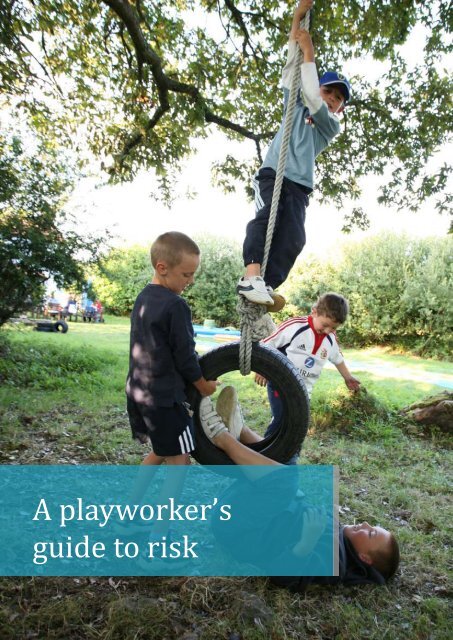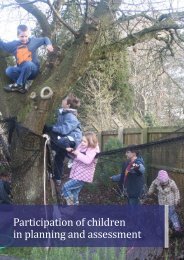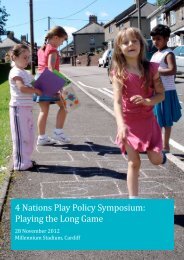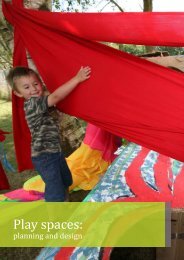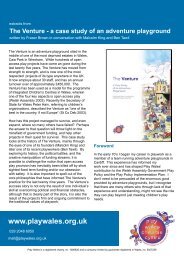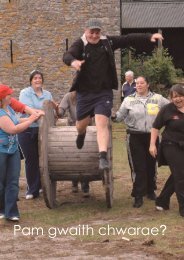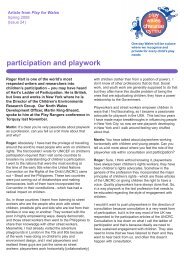Download A playworker's guide to risk - Play Wales
Download A playworker's guide to risk - Play Wales
Download A playworker's guide to risk - Play Wales
You also want an ePaper? Increase the reach of your titles
YUMPU automatically turns print PDFs into web optimized ePapers that Google loves.
A playworker’s<br />
<strong>guide</strong> <strong>to</strong> <strong>risk</strong>
What do we mean by <strong>risk</strong> in terms of play provision?<br />
We mean providing opportunities for all children <strong>to</strong> encounter or create uncertainty,<br />
unpredictability, and potential hazards as part of their play. We do not mean putting children in<br />
danger of serious harm.<br />
Every child is different; one child’s idea of a <strong>risk</strong>y situation might be another’s idea of something<br />
‘easy-peasy’. We do not force children <strong>to</strong> do anything that they feel is beyond them, or<br />
encourage them <strong>to</strong> go any further than they feel safe. Neither do we simply leave children <strong>to</strong><br />
fend for themselves.<br />
If in doubt, or if we are unfamiliar with the child, we err on the side of caution; we have a duty of<br />
care <strong>to</strong>wards the children in our setting.<br />
We need <strong>to</strong> be aware that some disabled children will have been excluded from potentially <strong>risk</strong>y<br />
situations, and that inclusive practice means opening up or supporting all children in creating<br />
what are <strong>risk</strong>y play opportunities for them.<br />
What does balancing <strong>risk</strong> with benefit and<br />
well being mean?<br />
<strong>Play</strong>work Principle 8 says: playworkers choose<br />
an intervention style that enables children<br />
and young people <strong>to</strong> extend their play. All<br />
playworker intervention must balance <strong>risk</strong> with<br />
the developmental benefit and well being of<br />
children.<br />
As playworkers we make decisions all the<br />
time. This part of Principle 8 means we make<br />
a decision: is the good this child or children<br />
will gain from this experience stronger than the<br />
likelihood of their coming <strong>to</strong> serious harm?<br />
Good – children getting <strong>to</strong> know what they<br />
can manage, children growing physically and<br />
mentally stronger, children learning skills,<br />
children gaining new knowledge, children<br />
gaining a sense of achievement, children<br />
growing in confidence, children feeling<br />
empowered and children participating and<br />
making a contribution.<br />
Serious harm – children dying, children being<br />
seriously and permanently injured or physically<br />
impaired, the onset of life threatening illness,<br />
children experiencing severe long term mental<br />
trauma.<br />
Scrapes, bumps and bruises, minor cuts,<br />
small burns, getting wet or muddy, and bruised<br />
pride are all part of growing up – they do not<br />
mean serious harm unless any of them are<br />
life threatening or likely <strong>to</strong> lead <strong>to</strong> long term<br />
severe illness.<br />
The right place<br />
We also need <strong>to</strong> be sure that the setting we<br />
work in is suitable for <strong>risk</strong>y play opportunities.<br />
If we were sports coaches we would not<br />
organise a full-on rugby match on a tarmac car<br />
park because it is not appropriate for playing<br />
rugby; the <strong>risk</strong> of injury is all <strong>to</strong>o evident and<br />
if we are weighing up good against harm our<br />
scales would weigh down heavily on the harm<br />
side in this instance.<br />
If we are working in a church hall or a sports<br />
centre we need <strong>to</strong> be aware of the limitations<br />
of the environment – small spaces and hard<br />
floors do not lend themselves <strong>to</strong> the kind of<br />
running around, jumping and climbing that<br />
some children wish <strong>to</strong> do. We either adapt<br />
the setting so that we can minimise the <strong>risk</strong> of<br />
injury without s<strong>to</strong>pping the children, or we find<br />
a more appropriate environment where they<br />
can run, jump and climb, or we intervene so<br />
that they can change what they are doing in<br />
the light of our concerns.
Getting <strong>to</strong> know children<br />
If we are unfamiliar with the children we take a<br />
more cautious approach until we are confident<br />
that we know their capabilities. We introduce<br />
potential <strong>risk</strong> by starting small so that we can<br />
observe their reaction and make decisions<br />
as <strong>to</strong> whether <strong>to</strong> extend <strong>to</strong> slightly <strong>risk</strong>ier play<br />
opportunities.<br />
We always bear in mind that children will<br />
deliberately create their own uncertain and<br />
wobbly play opportunities – they will seek <strong>to</strong><br />
be ‘in control of being out of control’.<br />
Some play provision, for instance a play<br />
ranger project or short-term playscheme, may<br />
not give us enough opportunity <strong>to</strong> get <strong>to</strong> know<br />
new children well. If this is the case we use<br />
our judgment and we only support <strong>risk</strong>y play if<br />
we are comfortable <strong>to</strong> do so and feel that the<br />
<strong>risk</strong> of harm is low. There are lots of exciting<br />
play possibilities we can provide that offer the<br />
thrill of uncertainty with little <strong>risk</strong> of harm, we<br />
can save more ambitious ideas for a more<br />
appropriate time.<br />
Why do we need <strong>to</strong> provide or support<br />
children <strong>to</strong> create their own opportunities<br />
that have a potential <strong>risk</strong>?<br />
If children have opportunities <strong>to</strong> encounter<br />
uncertainty and deal with potential hazards<br />
they develop resilience – they can deal better<br />
with what our uncertain world throws at them.<br />
If they are protected from anything that is<br />
potentially emotionally or physically harmful<br />
they will have less chance <strong>to</strong> be resilient<br />
robust people who can stand on their own two<br />
feet and take life’s knocks.<br />
Children need and seek out <strong>risk</strong> – it is a<br />
natural part of growing up – it is a way of<br />
learning how <strong>to</strong> survive. If we don’t introduce<br />
or support opportunities <strong>to</strong> experience <strong>risk</strong><br />
in a play setting, children will seek the thrill<br />
and sense of achievement that comes with<br />
overcoming fears, in places that are less<br />
appropriate where there are no experienced<br />
people around <strong>to</strong> keep an eye on them. They<br />
can practice taking <strong>risk</strong>s within the relatively<br />
safe setting of a play space.<br />
In this country our culture tends <strong>to</strong> suggest<br />
that children are incompetent and incapable –<br />
we start from a position of distrusting them <strong>to</strong><br />
be able <strong>to</strong> fend for themselves.<br />
In other cultures, even those as close <strong>to</strong> us<br />
as Northern Europe, small children use axes<br />
<strong>to</strong> chop fire wood or walk <strong>to</strong> school on their<br />
own as a matter of cus<strong>to</strong>m – they are seen<br />
as competent and capable. They have been<br />
gradually introduced <strong>to</strong> these situations from<br />
an early age – they have gradually built up<br />
skills and confidence, the culture is that adults<br />
respect and trust children. The difference<br />
in the level of competence and capability<br />
between these children and those in our<br />
settings is our attitude <strong>to</strong>wards them – the<br />
experience we provide them, the expectations<br />
we have and the assumptions we make.<br />
These days our culture has grown <strong>to</strong> be more<br />
and more against taking <strong>risk</strong>s; children may<br />
not have the opportunity <strong>to</strong> experience the<br />
simple pleasure of jumping off a wall or playing<br />
conkers, or catching raindrops in their open<br />
mouth, in their everyday lives. It is not long<br />
ago in his<strong>to</strong>ry since children climbed trees, or<br />
made slides in the snow and no-one thought<br />
twice about it, it was considered natural and<br />
necessary. On very rare occasions a child<br />
would be harmed in their pursuit of thrills and<br />
spills, but this was considered an everyday<br />
part of life – an accident. Few things have<br />
changed since then except our level of fear<br />
and the constant (very often empty) threat<br />
of being taken <strong>to</strong> court or having a claim for<br />
compensation made against us.<br />
It is highly unlikely that a competent<br />
playworker will ever be taken <strong>to</strong> court and<br />
successfully prosecuted for negligence<br />
because the safeguards that we put in place<br />
<strong>to</strong> protect both ourselves and the children are<br />
sensible and show that we have a professional<br />
approach <strong>to</strong> <strong>risk</strong>.<br />
How do we support children in creating<br />
‘Any person who tells me they would be a<br />
good stunt person because they have no<br />
fear is instantly dismissed. No fear means<br />
no respect for danger.’<br />
A stunt co-ordina<strong>to</strong>r
CASE STUDY<br />
Leeds <strong>Play</strong> Network runs street play<br />
projects with outreach playworkers,<br />
who do not shy away from providing<br />
opportunities for children <strong>to</strong> take part in<br />
‘<strong>risk</strong>y play’.<br />
During one of their sessions a boy<br />
jumped in<strong>to</strong> long grass and badly cut<br />
his leg on a discarded razor blade. The<br />
boy’s mother <strong>to</strong>ok him <strong>to</strong> hospital. He<br />
needed stitches, but he was fine and<br />
within a couple of days he had returned<br />
<strong>to</strong> play at the project. In the meantime<br />
his mother, supported by a “No Win<br />
No Fee” law firm, put in a claim for<br />
compensation for the injury.<br />
The Direc<strong>to</strong>r of the Network<br />
immediately informed their insurance<br />
company who sent an assessor <strong>to</strong> find<br />
out “how much money it would take <strong>to</strong><br />
make the claimants go away” – <strong>to</strong> settle<br />
out of court. The Direc<strong>to</strong>r showed him<br />
the Network’s policies and procedures<br />
regarding <strong>risk</strong>, the <strong>risk</strong> assessment<br />
forms that are routinely completed,<br />
and he explained about the dynamic<br />
<strong>risk</strong> assessment that is part of all good<br />
playwork practice. He also showed<br />
the assessor the reflective diaries kept<br />
by the Network’s playworkers, that<br />
showed that on the day of the accident<br />
all reasonable effort had been made <strong>to</strong><br />
remove hazards from the site (e.g. “...<br />
picked up three shopping bags of dog<br />
muck <strong>to</strong>day!”).<br />
The assessor was reassured and<br />
reported back <strong>to</strong> the insurance<br />
company, who s<strong>to</strong>od up <strong>to</strong> the claim.<br />
The family backed down. At the same<br />
time the assessor recommended <strong>to</strong><br />
the insurance company that given the<br />
thorough way in which the Network<br />
and its playworkers approach <strong>risk</strong>, their<br />
liability level should be lowered, and<br />
their premiums should be reduced. As<br />
the result the Network now pays less<br />
for insurance than they did before the<br />
claim.<br />
<strong>risk</strong>y play opportunities?<br />
We start small and we do it cautiously in a<br />
common sense way.<br />
The <strong>Play</strong>work Principles do not say build a<br />
roaring bonfire as big as you can and then<br />
walk away and leave children <strong>to</strong> tend it. The<br />
<strong>Play</strong>work Principles do not say lift an unknown<br />
child out of her wheelchair and push her down<br />
a slide, nor do they say if a child wants <strong>to</strong> dip<br />
their hands in honey we let them do it and then<br />
we stand aside waiting for the wasps <strong>to</strong> arrive,<br />
or if a child who has little control of their arms<br />
wants <strong>to</strong> use a craft knife we hand it over and<br />
turn our back. The <strong>Play</strong>work Principles make<br />
the assumption that playworkers are sensible,<br />
responsible people who have common sense<br />
and will apply it <strong>to</strong> their job.<br />
In the case of those children in Northern<br />
Europe who cut wood with axes, they first<br />
watched others chopping wood and have then<br />
been gradually and sensitively introduced <strong>to</strong><br />
the skills involved; they weren’t handed an<br />
enormous axe at the age of two and given<br />
a pine tree <strong>to</strong> hew down on their own. They<br />
started with little <strong>to</strong>ols that they could easily<br />
hold in their little hands and they were closely<br />
supported so that they knew how <strong>to</strong> do the job,<br />
until they could do it confidently with minimal<br />
<strong>risk</strong>. The contribution this approach makes<br />
<strong>to</strong> children’s sense of their own competence<br />
and <strong>to</strong> their sense of worth and participation is<br />
immeasurable.<br />
As playworkers working <strong>to</strong> the <strong>Play</strong>work<br />
Principles, we take a cautious but not<br />
mollycoddling approach that recognises<br />
that the majority of children, the majority<br />
of the time, are competent <strong>to</strong> judge their<br />
own capabilities and will not wish <strong>to</strong> harm<br />
themselves. This means that if, for instance,<br />
children are using <strong>to</strong>ols, we keep an eye<br />
on them and the situation they are in, we<br />
continually <strong>risk</strong> assess – or judge the situation<br />
- and if it changes we make decisions that<br />
balance children’s safety with the benefits<br />
<strong>to</strong> them of say, overcoming their fears, or<br />
mastering a skill.<br />
If the balance tips more <strong>to</strong>wards potential harm
than potential good we intervene sensitively<br />
and change the situation <strong>to</strong> make it safer,<br />
always aware in deciding how <strong>to</strong> do this of the<br />
affect the intervention might have on the child.<br />
Fearsome Fire<br />
Providing experience of the elements is part<br />
of the playwork curriculum, but many of us<br />
are fearful of fire and worried about providing<br />
experience of fire for groups of children. On<br />
one hand we might make the argument that it<br />
won’t harm children if they never experience<br />
fire, on the other, would we wish <strong>to</strong> deprive<br />
children and young people of the joy and<br />
fascination that fire provides, and the sense of<br />
mastery?<br />
We all love looking in the flames and watching<br />
the changes that take place as something<br />
burns.<br />
Children need <strong>to</strong> know how <strong>to</strong> behave around<br />
fires for their own safety; how <strong>to</strong> light them<br />
and how <strong>to</strong> put them out – it is a life skill.<br />
If we don’t allow them <strong>to</strong> experience fire in<br />
our setting where else might they try it out?<br />
How many schools have been burnt down<br />
by children who didn’t realise how quickly<br />
the materials they were messing about with<br />
would burn once they had lit the s<strong>to</strong>len match?<br />
How many hillsides have gone up in smoke<br />
because a group of children wanted <strong>to</strong> see<br />
what would happen if they shone the sun<br />
through a magnifying glass on<strong>to</strong> dry grass?<br />
We can’t show children the danger of fire and<br />
the smothering qualities of thick smoke by<br />
holding their hand against a warm radia<strong>to</strong>r.<br />
If we want <strong>to</strong> introduce fire <strong>to</strong> our setting we<br />
start with a little candle or a little fire made<br />
of lollipop sticks in a biscuit tin. If we are<br />
working indoors we limit the fire in this way.<br />
We gradually introduce it and we make it<br />
an everyday thing. We always take safety<br />
precautions and we always keep an eye on the<br />
situation. Children do get excited about fires -<br />
fires are new and thrilling and fascinating<br />
- if they happen at a play setting once a<br />
year, then, just like Christmas, they generate<br />
plenty of giddy excitement which makes the<br />
situation unpredictable and difficult <strong>to</strong> <strong>risk</strong><br />
‘The only thing we have <strong>to</strong> fear is fear<br />
itself.’<br />
Franklin D. Roosevelt (former US President and<br />
wheelchair user)<br />
assess, if they happen regularly they become<br />
commonplace and no-one gets giddy.<br />
We need <strong>to</strong> remember that there are play<br />
settings in the UK that routinely provide fire<br />
as part of a range of experiences. Have any<br />
of them been prosecuted for allowing children<br />
<strong>to</strong> burn? No, because they have procedures<br />
and practices that mean the likelihood of<br />
injury is tiny. At settings where there is a<br />
fire every day, there is a culture that newlyintroduced<br />
children pick up; children share<br />
knowledge about safety, and newcomers copy<br />
the behaviour of more experienced children<br />
who know how <strong>to</strong> behave. There is always<br />
a playworker keeping an eye out who can<br />
intervene if children’s activity around the fire<br />
genuinely starts <strong>to</strong> threaten their safety.<br />
Respect for danger<br />
Some children may have or appear <strong>to</strong> have<br />
little sense of danger – some may have no<br />
experience from which <strong>to</strong> learn. We need <strong>to</strong><br />
treat each child as an individual <strong>to</strong> form our<br />
decision about the balance of good against<br />
serious harm. But children do not always<br />
operate as individuals – very often they<br />
operate as part of a group and sometimes<br />
groups of children egg each other on or<br />
become giddy. So we don’t simply make<br />
decisions based on our knowledge of<br />
individuals, we also make decisions based<br />
on our knowledge of how groups of children<br />
operate <strong>to</strong>gether.<br />
What do we fear?<br />
What blocks us from providing opportunities<br />
for <strong>risk</strong> taking within our play setting?<br />
Our own fear – the <strong>Play</strong>work Principles are<br />
not asking us <strong>to</strong> do anything with which we<br />
are deeply uncomfortable. If we are upset or<br />
distressed by having <strong>to</strong> provide a certain type
of play, we need <strong>to</strong> discuss this in supervision<br />
with our team leader or manager, or in<br />
men<strong>to</strong>ring sessions, we need <strong>to</strong> talk <strong>to</strong> our<br />
colleagues, identify training that might help<br />
and use our reflective diaries <strong>to</strong> examine why<br />
we are so fearful. We need <strong>to</strong> know whether<br />
our fear is reasonable. All of us have fears<br />
– some of them are easily unders<strong>to</strong>od (e.g.<br />
a fear associated with crossing busy roads)<br />
and others are harder <strong>to</strong> explain (e.g. a fear of<br />
money spiders) we are all human.<br />
Just as children need <strong>to</strong> be introduced <strong>to</strong> some<br />
potentially <strong>risk</strong>y play opportunities in small<br />
steps in order <strong>to</strong> build skills, judgment and<br />
confidence, so we need <strong>to</strong> take small steps<br />
<strong>to</strong>wards feeling comfortable with providing<br />
<strong>risk</strong>y play opportunities. We start small and we<br />
do it cautiously in a common sense way.<br />
Parental fear<br />
We may allow ourselves <strong>to</strong> be influenced by<br />
parents or carers who are frightened that their<br />
child might be harmed. We need <strong>to</strong> reflect on<br />
this – quality play opportunities involve some<br />
element of <strong>risk</strong> taking or creation, however<br />
small, and most parents will understand this if<br />
they think back <strong>to</strong> their own childhood.<br />
Parents need <strong>to</strong> have appropriate information:<br />
when we talk about providing opportunities for<br />
children <strong>to</strong> take <strong>risk</strong>s, we are not talking about<br />
<strong>risk</strong> at all cost and they need <strong>to</strong> know that we<br />
have procedures in place that minimise the<br />
danger of harm. Many of us are frightened<br />
of the unknown and the word <strong>risk</strong> has some<br />
negative meanings – we need <strong>to</strong> be able <strong>to</strong><br />
explain <strong>to</strong> parents why we are doing this (see<br />
earlier in this section). Ultimately if they are<br />
still unhappy they have the right <strong>to</strong> s<strong>to</strong>p their<br />
child attending – if we back down because<br />
one parent or carer complains we will be<br />
depriving many more children of quality play<br />
opportunities.<br />
Fear of being sued<br />
All play provision that employs playworkers<br />
must be insured against claims for<br />
compensation due <strong>to</strong> injury. If there has been a<br />
process of <strong>risk</strong> assessment and we can prove<br />
that we have taken reasonable care (as in the<br />
Leeds <strong>Play</strong> Network s<strong>to</strong>ry) then we are not<br />
personally liable and it is up <strong>to</strong> the insurance<br />
company <strong>to</strong> settle the claim as it wishes.<br />
Fear of being prosecuted<br />
If there has been a process of <strong>risk</strong> assessment<br />
and we can prove that we have taken<br />
reasonable care then we are not personally<br />
liable.<br />
Here is legal opinion from a barrister:<br />
I conclude that it is entirely<br />
legitimate ... <strong>to</strong> emphasise ... the need<br />
<strong>to</strong> balance against the <strong>risk</strong> of injury,<br />
the benefits <strong>to</strong> children and young<br />
persons of undertaking play activities<br />
within an acceptable level of <strong>risk</strong>.<br />
Central, however, <strong>to</strong> the exercise of<br />
the balance is the undertaking of a<br />
careful <strong>risk</strong> assessment. Where there<br />
has been a careful <strong>risk</strong> assessment,<br />
resulting in a conclusion that it is<br />
permissible for play <strong>to</strong> involve a <strong>risk</strong><br />
of injury, by reason of the resultant<br />
benefits, I am confident that Courts<br />
would be sympathetic <strong>to</strong> a Defendant,<br />
in the event of an accident and<br />
subsequent litigation.<br />
Raymond Machell QC, for <strong>Play</strong>link, 2006<br />
It’s <strong>to</strong>o much hassle<br />
if the real reason that we don’t want <strong>to</strong> provide<br />
play opportunities that might include <strong>risk</strong> is that<br />
we really can’t be bothered with the hassle<br />
of paperwork and keeping an eye on the<br />
children, then we need <strong>to</strong> reflect. The benefits<br />
<strong>to</strong> children have been covered earlier in this<br />
section, providing opportunities or supporting<br />
children <strong>to</strong> take <strong>risk</strong>s is as much part of our job<br />
as making sure there are enough supplies of<br />
paint or filling in the register.
Health and Safety Practice<br />
We’ve looked at why creating <strong>risk</strong> is such a<br />
vital part of children’s play and explored how<br />
we might introduce or support it despite some<br />
of the chal- lenges. How should we view our<br />
routine practice concerning health and safety?<br />
Just remember, time for PEE!<br />
Time for PEE - Prepare Expect Enjoy<br />
Prepare<br />
Make sure the play environment is checked<br />
and that checks are recorded. Make sure<br />
checks are a mix of visual checking and<br />
physical testing. All set- tings should have<br />
clear procedures on what should be checked,<br />
by whom and how often.<br />
Expect the best<br />
Do not look for the smallest and most unlikely<br />
pos- sibility of getting hurt in every activity. A<br />
very long chain of ‘what ifs’ are very unlikely<br />
<strong>to</strong> happen and they are not the focus of our<br />
playwork practice.<br />
<strong>Play</strong>workers use a careful but positive and<br />
practi- cal approach; we assess whether a<br />
child is compe- tent <strong>to</strong> make decisions about<br />
<strong>risk</strong> and hazards for themselves and we<br />
support them in their decision unless there is a<br />
real <strong>risk</strong> of serious harm.<br />
Enjoy<br />
As playworkers we are privileged <strong>to</strong> be<br />
able <strong>to</strong> operate in a world where play takes<br />
precedence. One of the best ways we can<br />
work within the guid- ance is <strong>to</strong> enjoy the play<br />
process.<br />
The enjoyment of play for what it is, <strong>to</strong> play<br />
with enthusiasm when invited <strong>to</strong> play, and<br />
<strong>to</strong> be a pas- sionate advocate for play, are<br />
the best ways <strong>to</strong> ensure an environment and<br />
atmosphere where children and young people<br />
can have their needs and rights met.<br />
The Health and Safety Executive<br />
says the following about ‘sensible<br />
<strong>risk</strong> management’<br />
We believe that <strong>risk</strong> management<br />
should be about practical steps <strong>to</strong><br />
protect people from real harm and<br />
suffering - not bureaucratic back<br />
covering. If you believe some of the<br />
s<strong>to</strong>ries you hear, health and safety is<br />
all about s<strong>to</strong>pping any activity that<br />
might possibly lead <strong>to</strong> harm. This is<br />
not our vision of sensible health and<br />
safety - we want <strong>to</strong> save lives, not<br />
s<strong>to</strong>p them. Our approach is <strong>to</strong> seek a<br />
balance between the unachievable aim<br />
of absolute safety and the kind of poor<br />
management of <strong>risk</strong> that damages lives<br />
and the economy.<br />
RESOURCES<br />
Health and Safety Executive: www.hse.gov.uk<br />
Managing Risk in <strong>Play</strong> Provision - A Position<br />
Statement<br />
Managing Risk in <strong>Play</strong> provision:<br />
Implementation Guide, David Ball, Tim Gill and<br />
Bernard Spiegal<br />
Myth of the Month<br />
Health and Safety Executive:<br />
www.hse.gov.uk/myth/index.htm<br />
Negligence, play and <strong>risk</strong> - legal opinion<br />
PLAYLINK: www.playlink.org<br />
No Fear, growing up in a <strong>risk</strong> adverse society,<br />
Tim Gill<br />
Royal Society for the Prevention of Accidents:<br />
www.rospa.com/playsafety/index.htm
2008<br />
www.playwales.org.uk<br />
<strong>Play</strong> <strong>Wales</strong> is the national organisation for children’s play, an independent charity supported<br />
by the Welsh Government <strong>to</strong> uphold children’s right <strong>to</strong> play and <strong>to</strong> provide advice and guidance<br />
on play-related matters.<br />
Registered charity no. 1068926<br />
A company limited by guarantee, no. 3507258<br />
Registered in <strong>Wales</strong>


